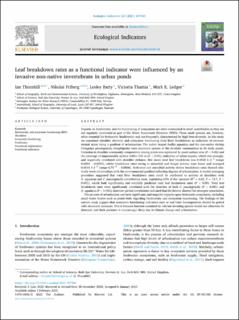| dc.description.abstract | Impacts on biodiversity and the functioning of ecosystems are often overlooked in small waterbodies as they are not regularly monitored as part of the Water Framework Directive (WFD). These small systems are, however, often essential for freshwater biodiversity and are frequently characterized by high beta-diversity. In this study we examined shredder diversity and ecosystem functioning (leaf litter breakdown) as indicators of environmental stress along a gradient of urbanisation. The native isopod Asellus aquaticus and the non-native shrimp Crangonyx pseudogracilis (Amphipoda) were dominant species of the shredder communities in 26 study ponds. Variation in shredder community composition among ponds was explained by pond surface area (P < 0.05) and the coverage of impermeable surface within 500 m (P < 0.05), indicative of urban impact, which was strongly, and negatively correlated with shredder richness. Site mean total leaf breakdown was 0.0020 k d−1 (range 0.0003 – 0.0053), whilst breakdown rates owing to microbial and fungal activity were lower and averaged 0.0010 k d−1 (range 6.72−5 − 0.0036). Both total and microbial activity driven breakdown rates showed relatively weak relationships with the environmental gradient reflecting degrees of urbanization. A model-averaging procedure suggested that total litter breakdown rates could be attributed to activity of shredders with A. aquaticus and C. pseudogracilis contributing most, explaining 65% of the variance (R2 = 0.65, F = 13.7, P < 0.001), which both significantly and similarly predicted total leaf breakdown rates (P < 0.05). Total leaf breakdown rates were significantly correlated with the densities of both C. pseudogracilis (P < 0.001) and A. aquaticus (P < 0.001), however partial correlations indicated that the former showed the strongest association. The process of urbanisation can have significant, and negative impacts upon freshwater ecosystems, including small water bodies such as ponds both regarding biodiversity and ecosystem functioning. The findings of the current study suggest that ecosystem functioning indicators such as leaf litter decomposition should be paired with structural measures. This is because function sustained by tolerant invading species would not otherwise be detected, and their presence is increasingly likely due to climate change and urbanization. | en_US |

